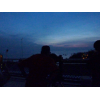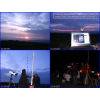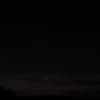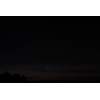Visibility of Jumadal Al-Aakherah Crescent 1431 AH
- When to Observe Jumadal Al-Aakherah Waxing (NEW) Crescent ?
- Jumadal Al-Aakherah Waxing (NEW) Crescent Observation Results
- The OFFICIAL First Day in Different Countries
- When to Observe Jumadal Al-Aula Waning (OLD) Crescent ?
- Jumadal Al-Aula Waning (OLD) Crescent Observation Results
When to Observe Jumadal Al-Aakherah Waxing (NEW) Crescent ?
The geocentric conjunction (Geocentric New Moon) will occur Inshalla on (Friday 14 May 2010) at 01:04 UT.
Sighting the new crescent on (Friday 14 May 2010) and (Saturday 15 May 2010) is shown in the below graphs using the program Accurate Times by Mohammad Odeh according to Odeh criterion. Where:-
- It is impossible to see the crescent from the areas located under the red color. Because either the Moon on this day sets before the Sunset and/or the topocentric conjunction occurs after the Sunset.
- The crescent is expected to be seen by optical aid only from the areas located under the blue color.
- The crescent is expected to be seen by optical aid from the areas located under the magenta color. In these areas the crescent could be seen by naked eye if the atmospheric conditions are superb and the observer is experienced.
- The crescent is expected to be easily visible by naked eye from the areas located under the green color.
- The crescent cannot be seen from uncolored areas, even though the Moon sets in these locations after the Sunset and the topocentric conjunction occurs before the Sunset, but the Moon is not sufficiently illuminated in order to be seen as crescent even by optical aid.
- Kindly notice that the below graph shows the possibility of seeing the crescent from areas between 60 degrees north of Equator down to 60 degrees south of Equator.
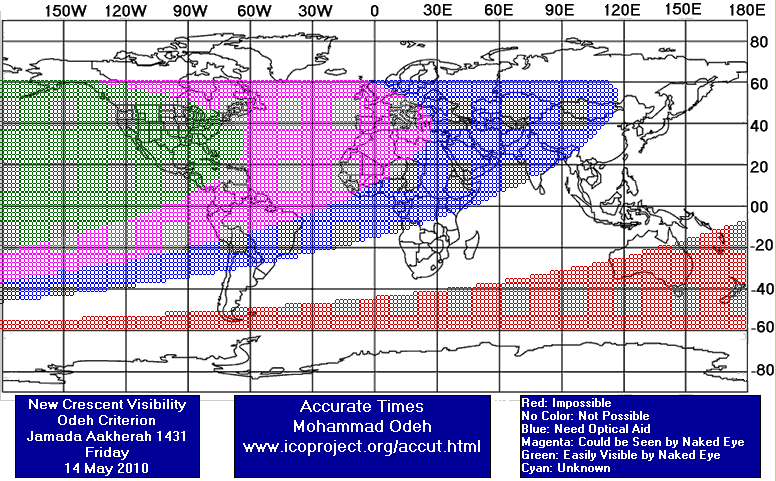

According to the Universal Hejric Calendar (UHC), which is based on the calculated crescent visibility, the start of this month in the Eastern Region will be on Saturday 15 May 2010 and in the Western Region will be on Saturday 15 May 2010. Kindly notice that the UHC is a pre-calculated calendar, which adopts a certain criterion to start the new Hejric month. Your country/organization might adopt different criterion to start the new Hejric month. So it is highly advised to read the UHC website before giving any judgment.
- Results of seeing the crescent, and the first day of the month in different countries will be added here Inshalla as we receive the reports from ICOP's members. If you wish to be a member in ICOP, or to know more about it, kindly click here.
Jumadal Al-Aakherah Waxing (NEW) Crescent Observation Results
Fri 14 May 2010
Algeria
Mr. Hocine Chikh Aissa said: "I was tried to observe the Jumada II 1430 crescent. The crescent was not seen. "
Germany
Malaysia
Mr. Kassim Bahali said: "1'st day of Jamdii Akhir 1431 begins on 15 May 2010."
Pakistan
Mr. Alam Sultan said: "On my request, nearly 300 persons (members of the moon-sighting committees of our institute "JAMIA-TUR-RASHEED" + my friends + their companions) tried to sight the moon at more than 28 places all over Pakistan but the moon could not be sighted, as it was astronomically expected tonight. It was almost clear today countrywide. Note 1: Chairman of central official moon sighting committee of Pakistan mufti munee-bur-Rahman told me on my mobile phone that as he also did not receive any positive report countrywide therefore he announced officially that Saturday 15 May is 30th Jumadal-oola and Sunday 16 May 2010 is 1st Juma-dath-thaniah 1431 in Pakistan. Note 2: After some days, inshaallah, a detailed report of this observation in Urdu will be available at www.esnips.com/web/moonnewsofjamiaturrasheed "
Saudi Arabia
Mr. Bander Albotehy said: "The weather conditions were very bad for sighting. The sky was cloudy and dusty."
Mr. Saleh Al-Saab said: "The crescent was 6.5 degrees above the horizon at sunset , but the weather was not helping. "
Senegal
United Kingdom
Eng. Qamar Uddin said: "On Friday 14 May 2010 (29 Jumada Al-Awwal 1431 AH) many people from throughout UK have attempted to sight the youngest crescent moon (Hilal) of Jumada Al-Thani after sunset. Most places were cloudy and none of the groups were able to sight the 19 hours old Hilal by naked eye, binoculars or telescopes. We have not received any reliable sighting news from any countries from East of UK either. Therefore, the Ulama have decided that the month of Jumada Al-Awwal 1431 AH will complete 30 days and the month of Jumada Al-Thani (or Jumada Al-Akhir) 1431 AH will start from Sunday 16 May 2010, Insha-Allah. May Allah rewards all those who have attempted to revive the Sunnah of moon sighting, this month. The Sutton Bank (Thirsk, North Yorkshire) group of 18 observers comprised of the following people. From Batley: Maulana Hasib Mayet & son Yusuf Mayet, Maulana Imran Lunat, Vaishullah Bodiyat, Yusuf Kayat, Nazir Bhana, Ismail Patel and Suleman Motala; From York: Qamar Uddin, Paul Buglass, Martin Dawson, Glen Berry, Garath Verney, Martin Whipp, Martin Hall, Phil Jennings and his two parents. Note that the Sutton Bank group also live webcasted the observation efforts to the Internet (see attached photos)."
United States
Dr. Javad Torabinejad said: "This evening (Friday, May 14, 2010), due to the presence of much haze and clouds in the western horizon in Blacksburg, VA, no detailed sighting was attempted. "
Sat 15 May 2010
Algeria
Mr. Hocine Chikh Aissa said: " (12) persons were present in N'tissa station and have tried to observe the Jumada II 1431 crescent ,the crescent was seen. They have arrived at the station in the sunset 19:34 exactly and seen the crescent in this time by the naked eyes and by two binoculars: 50x07 and 50x10."." "
Indonesia
Malaysia
Mr. Kassim Bahali said: "The hilal was seen from my observatory with naked eyes at Jasin Melaka. The images was taken with Meade telescope LX200 8" and canon EOS 50D. The western sky was partly cloudy."
Nigeria
Mr. Qamarudeen Muhammad said: "I couldn't get any information regarding the start of month of Jumdal Thanii from any source."
Pakistan
Mr. Alam Sultan said: "Alhamdolillah, We easily sighted the moon in Karachi and in many parts of country, as it was expected tonight astronomically. I requested many persons (members of the moon-sighting committees of our institute "JAMIA-TUR-RASHEED" + my friends + their companions) all over Pakistan to sight the moon. Many hundred Persons easily sighted the moon in all 4 provinces. It was almost clear today countrywide. Note : After some days, inshaallah, a detailed report of this observation in Urdu will be available at www.esnips.com/web/moonnewsofjamiaturrasheed "
Somalia
Mr. Abdulaziiz Hagi Bashiir said: "A lot of people saw the new crescent here in Garoowe. Sunday 16 May 2010 is the first day of Jumadulthani 1431H."
South Africa
Tanzania
Mr. Zaffar Sheriff said: "The sighting was confirmed at 6.16pm, just three minutes after sunset."
Trinidad and Tobago
Mr. Kahiam Hosein said: "The crescent to commence the month of Jumaadath Thaanii was CONFIRMED SIGHTED by all our committees in Trinidad and Tobago. It was also reported sighted in Barbados and Grenada. The sky was clear and the moon was clearly visible. The first night of the month is the night of Saturday 15th May 2010 and the 1st day is the day of Sunday 16th May 2010. (Mufti) Kahiam Hosein on behalf of Darul Uloom Trinidad and Tobago Moonsighting Committee"
United Kingdom
Eng. Qamar Uddin said: "On Saturday 15 May 2010, I was able to see the crescent moon (Hilal) using binoculars at about 21:05 BST (GMT+1) and then easily by naked eye after about 10 minutes from York (UK). Many people from other parts of UK also reported sighting the Hilal by naked eye soon after sunset. Note that I also practised live webcast of the Hilal observation to the Internet (see photo), although we had already decided the month of Jumada Al-Thani 1431 AH will start from Sunday 16 May 2010, the day before (i.e. by completing the month as 30 days)."
The OFFICIAL First Day in Different Countries
Fri 14 May 2010
1 . Nigeria
Sat 15 May 2010
1 . Indonesia
2 . Malaysia
3 . Saudi Arabia
4 . United States
Sun 16 May 2010
1 . Pakistan
2 . Senegal
3 . Somalia
4 . South Africa
5 . Tanzania
6 . Trinidad and Tobago
7 . United Kingdom
When to Observe Jumadal Al-Aula Waning (OLD) Crescent ?
The geocentric conjunction (Geocentric New Moon) will occur Inshalla on (Friday 14 May 2010) at 01:04 UT.
Sighting the OLD crescent on (Friday 14 May 2010) and on (Thursday 13 May 2010) is shown in the below graphs using the program Accurate Times by Mohammad Odeh according to Odeh criterion. Where:-
- It is impossible to see the OLD crescent from the areas located under the red color. Because either the Moon on this day rises after the Sunrise and/or the topocentric conjunction occurs before the Sunrise.
- The crescent is expected to be seen by optical aid only from the areas located under the blue color.
- The crescent is expected to be seen by optical aid from the areas located under the magenta color.. In these areas the crescent could be seen by naked eye if the atmospheric conditions are superb and the observer is experienced.
- The crescent is expected to be easily visible by naked eye from the areas located under the green color.
- The crescent cannot be seen from uncolored areas, even though the Moon rises in these locations before the Sunrise and the topocentric conjunction occurs after the Sunrise, but the Moon is not sufficiently illuminated in order to be seen as crescent even by optical aid.
- Kindly notice that the below graph shows the possibility of seeing the crescent from areas between 60 degrees north of Equator down to 60 degrees south of Equator.


Jumadal Al-Aula Waning (OLD) Crescent Observation Results
Thu 13 May 2010
Indonesia
United Kingdom
Eng. Qamar Uddin said: "I have tried to sight the waning crescent of Jumada Al-Awwal on both 12 and 13 May 2010 mornings before sunrise, but it was not seen. The horizon was totally cloudy on both days."
United States
Mr. Jim Stamm said: "Old Moon Crescent Observation Report ====================================== Observed: Thursday; May 13, 2010 - 05:27 (Local) Location (WGS 84) = Tucson, Arizona (USA) Longitude = 110.9651 W Latitude = 32.4206 N Elevation = 842 meters Time Zone = -7.0 hours Surface conditions at location: Temperature = 9 °C Humidity = 40 % Pressure = 29.83 in. Light, thin bands of clouds around the sky. Magnitude limit at 5.7 degrees altitude with 120 power in C-8 telescope, before onset of twilight = 11.2 Topocentric and local time values from “Accurate Times”: Moonrise (at sea level) = 04:47 Sunrise (at sea level) = 05:22 Time from new moon at 05:27 = 14 hr. 19 min. Moon lag time = 35 min. Relative Altitude = 6.5 degrees Elongation from sun = 6.9 degrees Crescent width = 7 arc seconds Illumination = 0.36 percent I was NOT able to see the crescent, even through a telescope. I believe that I might have seen it from Mt. Lemmon, but I wanted to test the possibility that a higher pointed altitude might be more advantageous than elevation, even though I would experience more scattered light. I believe that the conditions were good enough to eliminate that possibility for this time. However, this shoud be an area for further study. Observer: Jim Stamm E-mail Address: StammJim@gmail.com"
